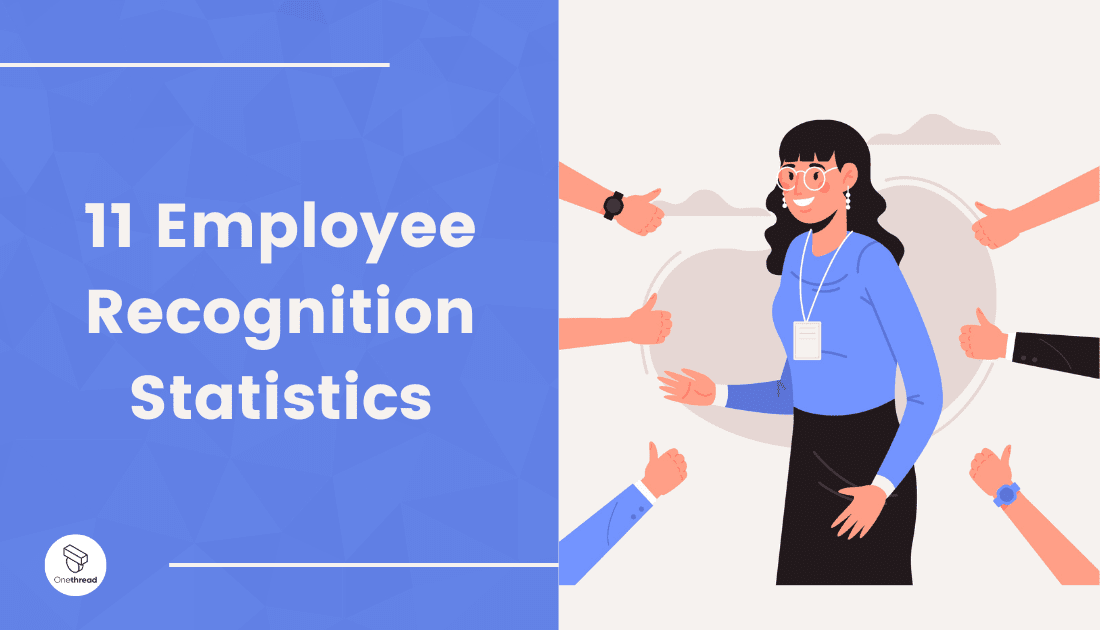Are you curious about the impact of employee recognition statistics on your organization? Look no further! In this article, we will dive into the statistics surrounding employee recognition and shed light on its importance in today’s work environment.
Employee recognition is not just a nice-to-have; it has become an essential aspect of fostering a motivated and engaged workforce. Studies have shown that organizations that prioritize employee recognition experience numerous benefits.
For starters, employees who feel appreciated are more likely to be satisfied with their jobs, leading to increased productivity and higher retention rates. Additionally, recognizing employees for their hard work and achievements can boost morale and motivation, ultimately resulting in improved performance across the board.
So if you’re wondering whether implementing an employee recognition program is worth it, the answer is a resounding yes! Let’s now explore some eye-opening statistics that highlight the significance of recognizing your employees’ efforts.
Why is Employee Recognition Important?
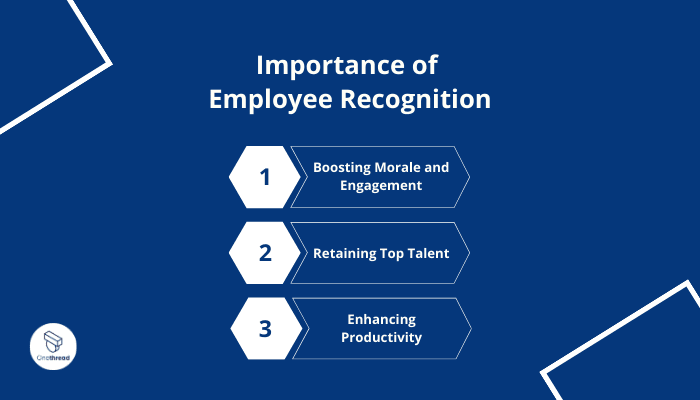
Employee recognition is an essential component of a thriving workplace. It acts as a radiant beam of sunshine, brightening the atmosphere and bolstering morale among employees. A thoughtfully crafted recognition program can amplify these positive effects, ensuring that employees feel valued and motivated to contribute their best.
By acknowledging and appreciating their hard work and contributions, organizations can foster an environment where individuals feel valued, leading to increased engagement and motivation.
Boosting Morale and Engagement
Employee recognition goes beyond a simple “thank you.” It involves recognizing and appreciating the specific achievements and contributions of each individual. This approach creates a positive work environment, empowering employees to perform at their best.
When employees feel valued and appreciated, their morale and job satisfaction soar, resulting in improved engagement and a willingness to go the extra mile.
Retaining Top Talent
Regular employee recognition plays a crucial role in retaining high-performing employees. When individuals receive acknowledgment for their efforts, they develop a stronger sense of commitment and loyalty to the company.
Research has shown that organizations with robust recognition programs experience lower turnover rates compared to those without such programs. By making employees feel valued, organizations reduce the likelihood of them seeking employment elsewhere.
Enhancing Productivity
Employee recognition also has a significant impact on productivity levels. When employees know that their hard work will be acknowledged and rewarded, they are motivated to excel in their tasks.
Recognizing outstanding performance not only encourages the recipient but also inspires others to strive for excellence. Consequently, the overall productivity of the team or organization improves significantly.
Understanding the importance of employee recognition is fundamental in creating a positive work environment where individuals feel valued and motivated. It not only boosts morale but also plays a vital role in retaining top talent and enhancing productivity.
By implementing effective recognition programs, companies can foster a culture of appreciation that leads to greater success in all aspects of business operations.
Recognizing employees’ achievements is fundamental in a thriving workplace, but traditional methods may not always capture the uniqueness of individual contributions. Opting for handcrafted custom awards can add a personal touch to these recognitions, making them more meaningful and memorable.
Whether it’s marking a significant company milestone or celebrating employee loyalty and excellence, these exquisite awards serve as a lasting token of appreciation and achievement.
Exploring Employee Recognition Programs: Formal, Informal, and Social Approaches
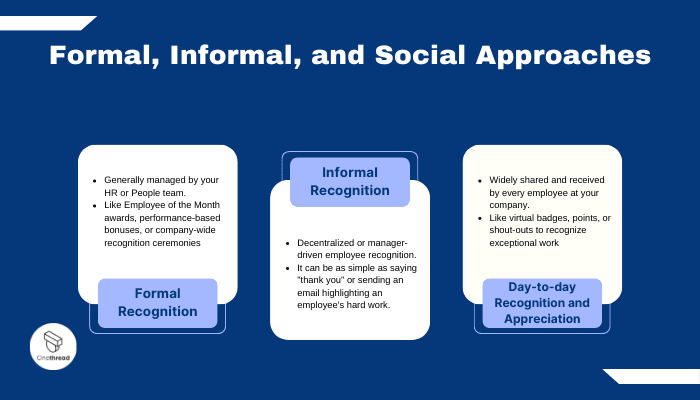



Employee recognition programs play a pivotal role in appreciating and acknowledging the hard work of team members. Understanding the different types of recognition programs allows organizations to select approaches that align with their culture and goals, ultimately fostering motivation and a positive work environment.
Employee recognition programs thrive on transparent, structured processes that ensure consistency. Similarly, businesses like Rent-A-Center implement verification steps for services like rent-to-own agreements. Understanding how Rent-A-Center verifies employment can provide insight into their operational processes, helping to ensure customers meet their payment obligations while maintaining trust and transparency
Formal Recognition Programs
Formal recognition programs involve structured methods of acknowledging outstanding achievements. This can include Employee of the Month awards, performance-based bonuses, or company-wide recognition ceremonies.
By publicly honoring employees, formal programs encourage healthy competition and provide a tangible symbol of appreciation.
Informal Recognition Programs
The informal or day-to-day recognition approach focuses on regular expressions of gratitude and acknowledgment. It can be as simple as saying “thank you” or sending an email highlighting an employee’s hard work.
Informal programs foster positive relationships between managers and employees, creating a culture of respect and appreciation.
Day-to-Day Recognition Programs
Daily recognition leverages technology to facilitate peer-to-peer appreciation. Platforms allow colleagues to give virtual badges, points, or shout-outs to recognize exceptional work. Daily recognition promotes camaraderie within teams and transparency throughout the organization, highlighting achievements and inspiring others.
11 Mind-Blowing Employee Recognition Stats You Need to Know
Employee recognition is more than just a feel-good gesture; it has a tangible impact on organizational success. Here are 11 mind-blowing employee recognition stats you need to know, showcasing the power and benefits of acknowledging and appreciating your workforce.
1. Employee Recognition as a Key Driver of Engagement
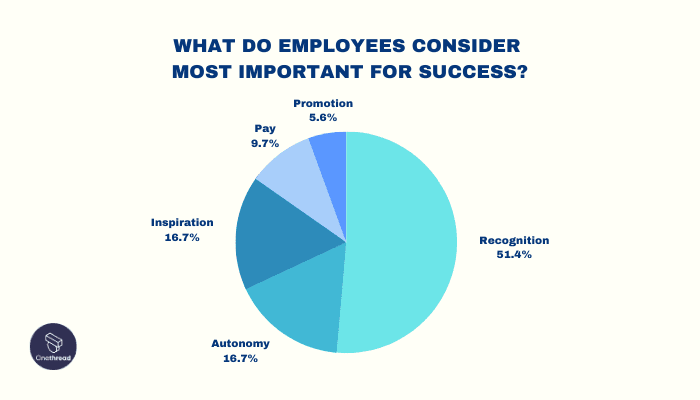



According to a study conducted by Zippia, 37% of employees believe that employee recognition is the main area where leaders can improve employee engagement. When employees feel appreciated and recognized for their efforts at work, it helps foster the connections needed for them to become engaged.
Recognition goes beyond monetary compensation and can be as simple as giving a daily shoutout or expressing gratitude through a thank you. By implementing effective recognition practices, leaders can create a positive work environment that encourages employee engagement and loyalty.
2. The Impact of Employee Appreciation Statistics and Satisfaction




A study by socialcast found that 69% of employees would be willing to work harder if they felt their efforts were better appreciated. Many employees desire recognition for their contributions, and the lack of appreciation can make them feel undervalued.
In fact, a Timesjob study revealed that 59% of employees feel that their bosses don’t show enough appreciation, leading to a sense of being undervalued. It is crucial for leaders to show gratitude and make employees feel competent and valued in order to drive productivity and job satisfaction.
3. Employee Recognition and Their Opinions
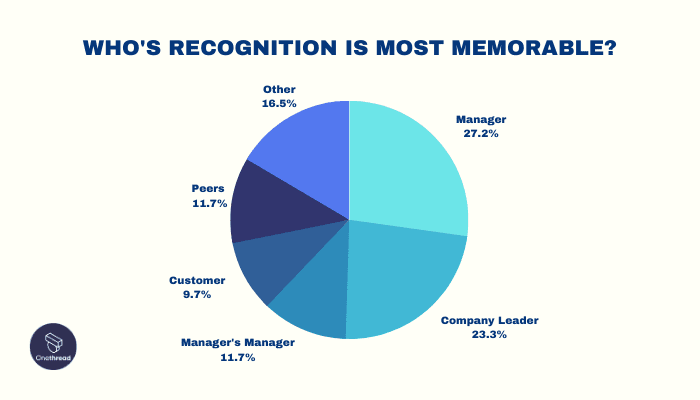



According to a Zippia study, 39% of the employees believe that they are under-recognized at their workplaces, among which 29% say they are not recognized at all.
More interestingly, employees who feel that they are properly recognized by their managers and peers at work, feel 2.6 times more motivated than their less-recognized counterparts. 28% of the surveyed employees say that they expect recognition from their managers or their top leadership like CXO’s.
4. Individual Performance and Employee Engagement




According to Aberdeen Group’s research titled “The Power of Employee Recognition, 2013”, 60% of the leading organizations agree that employee recognition is a powerful factor in driving individual performance.
An employee who feel properly recognized feels more motivated to carry out the responsibilities assigned to them and sometimes they even exceed those.
5. Employee Recognition Programs and Reduced Turnover
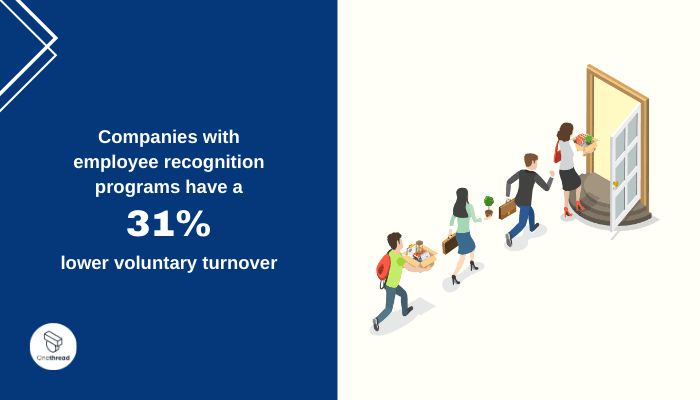



Companies that have implemented employee recognition programs experience a 31% lower voluntary turnover rate, as reported by Deloitte.com. Employee turnover can be attributed to feelings of unappreciation and job dissatisfaction.
However, recognition can serve as a powerful solution to address these issues and mitigate turnover problems. By implementing an effective employee recognition program, organizations can create a high-performance culture that values and appreciates its employees, resulting in increased loyalty and reduced turnover.
Creating an Effective Employee Recognition Program
In today’s workplace, an employee recognition program is not just a nice-to-have but a critical aspect of fostering employee satisfaction and engagement.
Here are some ideas that employees will love:
Public Recognition:
- Surprise parties for top performers, complete with cakes, confetti, and their favorite music.
- Bragging about their achievements on social media platforms.
- Publishing success stories in the company’s newsletter.
- Congratulatory announcements during team meetings.
Pro tip: Utilize collaboration and communication tools like OneThread to make company-wide announcements and keep everyone informed in one place.
Private Recognition:
- Leaving a sticky note on their desk with a message of “well done.”
- Sending a box of chocolates or a small gift to their home.
- Arranging a thank you or well-done meeting to personally express appreciation and acknowledge their efforts.
6. Building Trust through Gratitude and Appreciation




According to a study conducted by Cicero Group, it was found that 50% of employees believe that being thanked by their managers not only improves their relationship with their higher-ups but also helps in building trust.
Managers need to prioritize developing strong relationships with their employees, and expressing gratitude is an effective way to gain their trust. By appreciating the efforts of their team members, managers create an atmosphere of recognition and acknowledgment, fostering mutual trust between both parties.
Trust in the workplace is a two-way street, and allowing employees to take control and responsibility for projects also demonstrates faith in their abilities, further reinforcing the bond of trust.
7. Long-Term Employee Retention through Valuing and Recognition
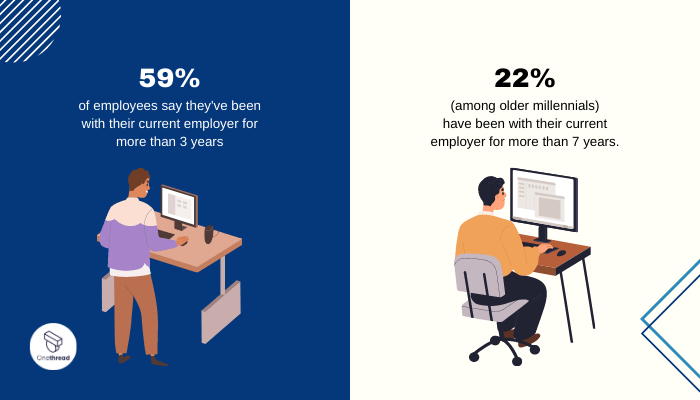



Udemy, in a recent survey, found that 59% of employees have remained with their current employer for more than 3 years. Additionally, among older millennials, 22% have been with their current employer for more than 7 years.
This data highlights the importance of keeping employees satisfied and engaged to ensure their long-term commitment to the organization. Happier employees are more likely to stay with their employer, and investing in measures that make employees feel valued and appreciated goes beyond meeting their basic needs.
By going the extra mile to recognize their hard work and contributions, employers can significantly boost employee morale and increase their dedication to the organization.
8. Effective Recognition Strategies for Managers
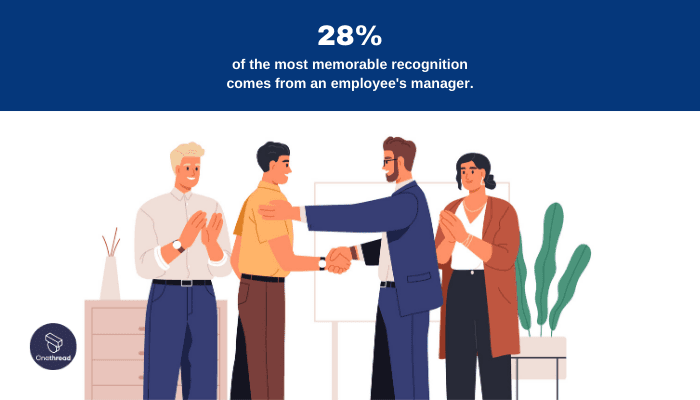



According to Gallup, 28% of the most memorable recognition comes directly from an employee’s manager. This emphasizes the critical role managers play in fostering a culture of recognition and appreciation.
To maximize the impact of recognition efforts, managers should aim to provide feedback as frequently and as closely as possible to the employee’s performance. Scheduling regular feedback sessions with direct reports allows for focused discussions on individual achievements and provides opportunities for group recognition.
By dedicating time and effort to recognize and acknowledge their employees’ contributions, managers can create a positive work environment that promotes productivity, engagement, and long-term loyalty.
9. Incorporating Recognition Programs into Company Culture




According to a survey conducted by worldatwork.org, only 14% of companies consistently feature recognition programs as part of their recruitment efforts. To create a strong company culture, it is crucial to communicate and actively incorporate recognition programs into the organization.
By highlighting the importance of employee recognition from the outset, companies can attract and retain top talent who value being appreciated and acknowledged for their contributions.
10. The Link between Effective Rewards Programs and Employee Satisfaction
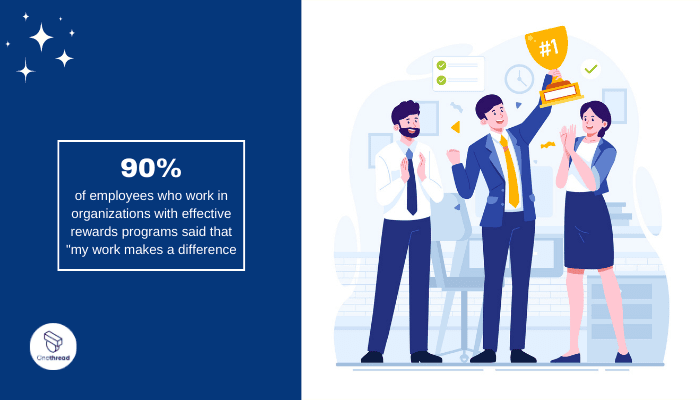



AttaCoin found that 90% of employees in organizations with effective rewards programs stated that their work makes a difference. This highlights the significant impact recognition programs have on employee satisfaction and engagement.
Regardless of the generation, employees seek direction and want to feel that their efforts have meaning and create an impact. Employee recognition awards and programs serve as a powerful tool to validate and reinforce the value of their contributions.
11. Considerations for Multigenerational Rewards Programs
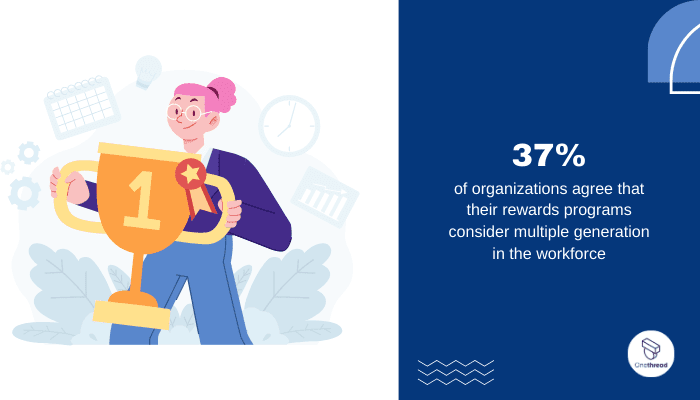



The Conference Board of Canada reported that 37% of organizations have rewards programs designed to cater to multiple generations in the workforce. This is especially important considering the shifting demographics, with millennials being more likely to change jobs frequently.
On average, millennials may have up to five different employers within a 10-year span, making it challenging for them to qualify for traditional long-service recognition.
By designing rewards programs that consider the preferences and needs of different generations, organizations can ensure that their recognition efforts resonate with employees across the board, promoting engagement and retention.
Effective Employee Recognition Strategies for a Millennial Workforce
Understanding the Importance of Recognition for Millennials
Millennials, the largest generation in today’s workforce, place a significant emphasis on employee recognition. They seek appreciation from their employers and expect timely feedback. To foster a sense of appreciation and create a positive work environment, it is essential to implement effective recognition strategies. The following examples highlight the key approaches to make millennial employees feel valued and cherished.
Recognizing Extra Effort and Outstanding Results
Acknowledging personal victories and significant accomplishments is crucial for motivating employees. When a team member goes above and beyond expectations, it is important to provide recognition.
Simple gestures like gift cards or movie tickets can demonstrate appreciation and strengthen work relationships. Additionally, expressing thanks through verbal or written means, such as email or handwritten notes, serves as a quick and inexpensive way to show gratitude for everyday efforts.
Merchandise awards can also be utilized to reward noticeable results.
Implementing Employee Bonus Programs
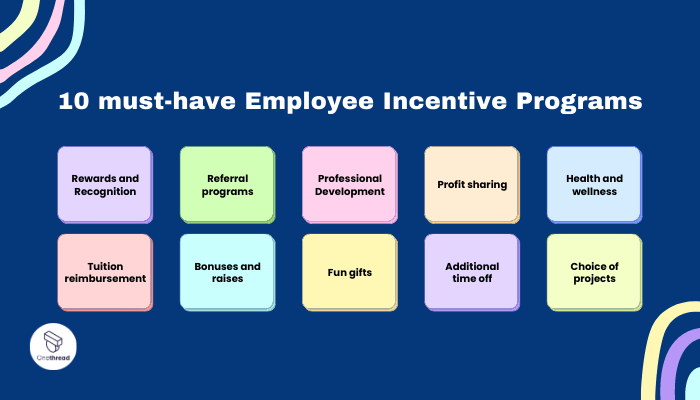



Implementing an employee bonus program is an effective way to showcase appreciation for ongoing dedication and individual contributions. These programs can focus on various objectives, including rewarding and retaining top performers, promoting positive behavior among employees, and increasing commitment towards organizational goals.
There are different types of bonuses to consider, such as performance-based bonuses for achievements over specific timeframes (e.g., annually or semi-annually), spot bonuses for immediate recognition of outstanding contributions, sign-on bonuses to attract new talent, referral bonuses, and random bonuses.
Recognizing Years of Service
Celebrating employees who reach significant milestones in their years of service is a powerful recognition strategy. By recognizing their loyalty and commitment, you create a sense of belonging and reinforce their value within the organization.
It is important to create a memorable experience for these individuals and carefully choose the right words to express gratitude for their years of service. This approach enhances employee morale and strengthens their connection to the company.
The Impact of Recognition on Workplace Culture
Recognition also plays a vital role in shaping the six essential aspects of workplace culture:
- Purpose: Recognizing employees reinforces the significance of their work and aligns them with the organization’s mission and values.
- Opportunity: Recognition creates opportunities for growth, advancement, and development within the company.
- Success: Acknowledging achievements enhances employees’ sense of accomplishment and motivates them to strive for continued success.
- Wellbeing: Recognition contributes to employee well-being by fostering a positive work environment and promoting a healthy work-life balance.
- Appreciation: Demonstrating appreciation through recognition strengthens employee engagement and overall job satisfaction.
- Leadership: Effective recognition strategies reinforce positive leadership practices and inspire employees to become future leaders themselves.
Conclusion
In conclusion, employee recognition statistics is a crucial aspect of any successful organization. By acknowledging and appreciating the efforts and achievements of their employees, companies can foster a positive work environment and improve employee morale.
The benefits of employee recognition are numerous, including increased productivity, higher job satisfaction, and reduced turnover rates. Implementing effective employee recognition programs requires careful planning and consideration.
It’s important to choose the right type of program that aligns with the company’s values and goals. Additionally, regularly evaluating the impact of these programs can be instrumental in refining strategies to ensure maximum effectiveness.
Ultimately, creating a culture of recognition is not just about rewards or incentives; it’s about making employees feel valued and appreciated for their contributions. When employees feel recognized for their hard work, they are more likely to go above and beyond in their roles. So, investing in employee recognition is not only beneficial for individual employees but also for the overall success of the organization.
Frequently Asked Questions
How Can Employee Recognition Enhance Employee Engagement And Motivation?
Employee recognition enhances employee engagement and motivation by making employees feel valued and appreciated. When employees are recognized for their hard work, they are more likely to be motivated to continue performing at a high level.
What Are Some Common Challenges Faced When Implementing An Employee Recognition Program?
Some common challenges you may face when implementing an employee recognition program include lack of management support, difficulty in defining clear criteria for recognition, and resistance to change from employees.
How Can Employee Recognition Contribute To Reducing Employee Turnover And Increasing Retention Rates?
Employee recognition can contribute to reducing employee turnover and increasing retention rates by fostering a positive work environment, boosting morale, increasing job satisfaction, and creating a sense of loyalty among employees.
Are There Any Specific Industries Or Sectors That Have Seen Significant Success With Employee Recognition Programs?
There are several industries or sectors that have seen significant success with employee recognition programs. Some examples include technology companies, healthcare organizations, and hospitality businesses. These industries have prioritized employee engagement and retention through recognition initiatives.
What Are Some Potential Drawbacks Or Limitations Of Implementing Employee Recognition Initiatives?
Some potential drawbacks of implementing employee recognition initiatives include the risk of creating a competitive environment, favoritism among employees, and potential resentment from those who are not recognized.
